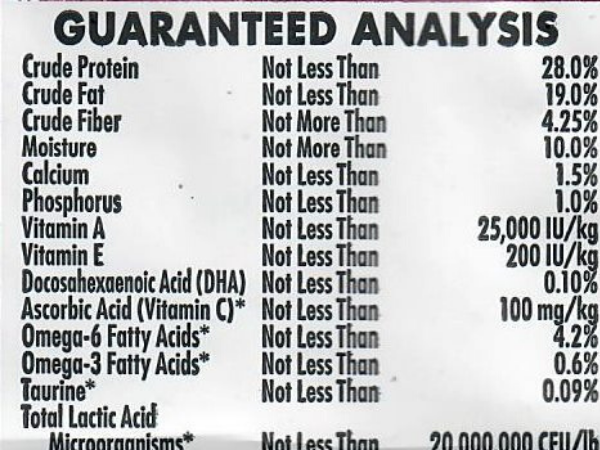Ingredient panels on all pet foods must list all of the ingredients present in the food in order of weight. Understanding the ingredient panels will allow you, the consumer, to make more educated decisions when making your pet’s nutrition choices as you will be able to better identify the foods that offer the quality that you are looking for. Here are some tips on how to read ingredient labels.
-
Ingredients are listed by weight. This means that the first ingredient comprises the highest percentage in content vs. all other ingredients listed.
- Please note that “ingredient splitting” on the label could artificially raise a higher quality meat item on the list and lower inferior quality ingredients making the food appear to be of higher quality than it really is. Read more on ingredient splitting here.
- Understand that ingredients should be compared on a “dry matter” (moisture removed) basis. Don’t be fooled by claims from manufacturers that others are bad because they list “meat meal” 2nd on an ingredient panel vs. their “meat” listed as the first ingredient. Meat is typically 75% moisture vs “meal” which is typically only at 10% moisture content, so moisture would need to be removed to provide an accurate comparison.
- The first five ingredients typically make up 80% of the total ingredients. Generally speaking, the shorter an ingredient panel the cleaner the food and your pet is less likely to have issues with any of the ingredients.
- Every ingredient matters. Be sure to read all the way through the ingredient panel to understand exactly what is in the food. It is very common for artificial colors, flavors and other additives to be listed at the very end of the ingredient panel.
- Guaranteed Analysis. This panel indicates the minimum and maximum nutrient levels on an “as fed” basis. All pet foods must show the percentages of crude protein, fat, fiber and moisture. If they choose to, the manufacturers can show additional information on Omega 3 & 6 and vitamin levels.
- Calorie content and feeding guidelines. This is information that is intended to provide you with guidelines on how much to feed your pet and the calories included in their established serving sizes. Your pets activity levels, overall health and any medical issues may affect feeding guidelines.


